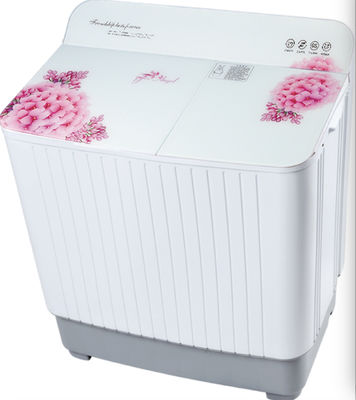|
|
Full Size Twin Tub Washing Machine With Heater , Portable Washer And Spinner
Product Details:
Payment & Shipping Terms:
|
| Brand Name: | O.E.M | Power: | 220V/110V |
|---|---|---|---|
| Automatic Type: | Semi-auto | Cabinet: | PP |
| Plug: | Optional | Cover Material: | Tempered Glass |
| Highlight: | twin drum washing machine,dual tub washing machine |
||
Full Size Twin Tub Washing Machine With Heater , Portable Washer And Spinner
Clothes washer technology developed as a way to reduce the manual labor spent, providing an open basin or sealed container with paddles or fingers to automatically agitate the clothing. The earliest machines were hand-operated and constructed from wood, while later machines made of metal permitted a fire to burn below the washtub, keeping the water warm throughout the day's washing.
The earliest special-purpose mechanical washing device was the washboard, invented in 1797 by Nathaniel Briggs of New Hampshire.[2][3]
By the mid-1850s steam-driven commercial laundry machinery were on sale in the UK and US.[4] Technological advances in machinery for commercial and institutional washers proceeded faster than domestic washer design for several decades, especially in the UK. In the United States there was more emphasis on developing machines for washing at home, though machines for commercial laundry services were widely used in the late 19th and early 20th centuries.[5] The rotary washing machine was patented by Hamilton Smith in 1858.[3] As electricity was not commonly available until at least 1930, some early washing machines were operated by a low-speed, single-cylinder hit-and-miss gasoline engine.
After the items were washed and rinsed, water had to be removed by twisting. To help reduce this labor, the wringer/mangle machine was developed. As implied by the term "mangle," these early machines were quite dangerous, especially if powered and not hand-driven. A user's fingers, hand, arm, or hair could become entangled in the laundry being squeezed, resulting in horrific injuries; unwary bystanders, such as children, could also be caught and hurt. Safer mechanisms were developed over time, and the more hazardous designs were eventually outlawed.
The mangle used two rollers under spring tension to squeeze water out of clothing and household linen. Each laundry item would be fed through the wringer separately. The first wringers were hand-cranked, but were eventually included as a powered attachment above the washer tub. The wringer would be swung over the wash tub so that extracted wash water would fall back into the tub to be reused for the next load.
The modern process of water removal by spinning did not come into use until electric motors were developed. Spinning requires a constant high-speed power source, and was originally done in a separate device known as an "extractor". A load of washed laundry would be transferred from the wash tub to the extractor basket, and the water spun out in a separate operation.[6][7] These early extractors were often dangerous to use, since unevenly distributed loads would cause the machine to shake violently. Many efforts were made to counteract the shaking of unstable loads, such as mounting the spinning basket on a free-floating shock-absorbing frame to absorb minor imbalances, and a bump switch to detect severe movement and stop the machine so that the load could be manually redistributed.
![]()
Tel: 86-574-58588616
Fax: 86-574-63579688
-
8.5kg House Twin Tub Washing Machine , Twin Tub Washer Spin Dryer With Plastic Cover Switch
-
Water Efficient Movable 7.8kg Household Dual Tub Washing Machine With White Plastic Cover
-
Quiet Plastic 10kg Twin Tub Washing Machine With Optional Shapes Knobs Colorful Decoration Inlays
-
Lightweight Stackable Large Capacity White 2 Tub Washing Machine With Shapes Knobs 830*535*970
-
Semi Automatic Twin Tub Washing Machine , Portable Washer And Spin Dryer With Hidden Glass Panel
-
High Effieiency Small Portable Washing Machine With Dryer For Apartment Low Noisy






